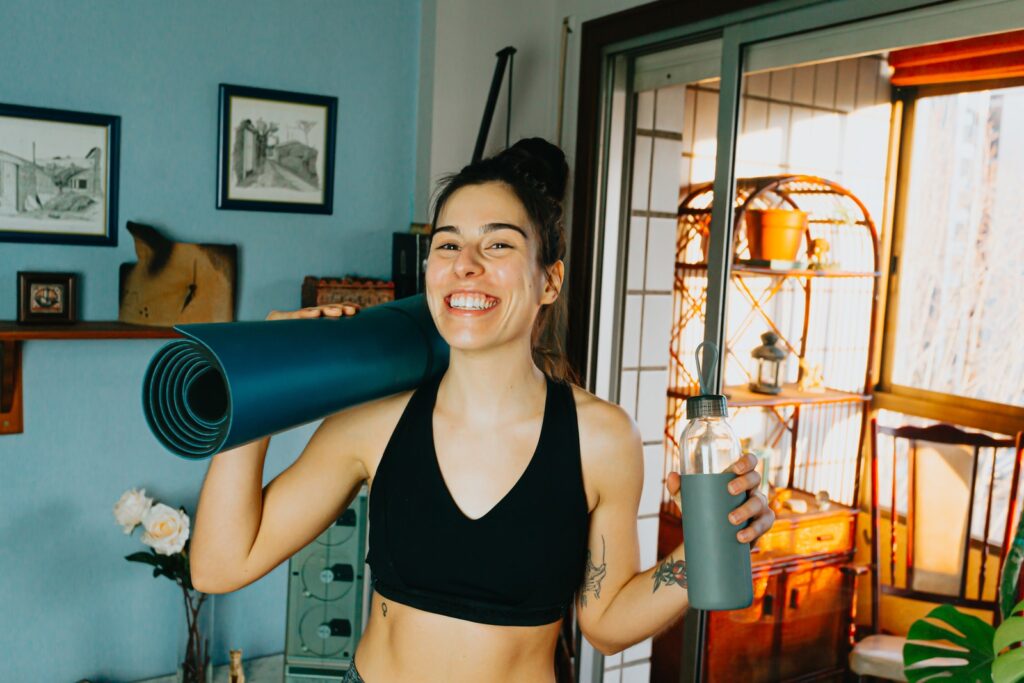- 12 basic Yoga poses for beginners with namess:
- yoga poses for beginners pdf:
- 5 best yoga poses for beginners:
- Warrior 2 yoga pose (Virabhadrasana II)
- Spinal Twist yoga pose (Supta Matsyendrasana):
- standing yoga poses for beginners:
- yoga for kids:
- Yoga For Kids – Activity To Play And Relax With Children:
- When and How Children Can Practice Yoga:
- The Benefits of Yoga For Children:
- Yoga, Adapted To The Personality Of Each Child:
- the top 7 benefits that help children:
- 1 – Bridge pose (Setu Bandha Sarvangasana):
- 2 – Tree yoga Pose (Vrksasana)
- 3- Cobra yoga Pose (Bhujangasana):
- 4-Cat yoga pose (Marjaryasana):
- 5-Bow yoga pose (Dhanurasana):
- 6- Frog pose (Mandukasana):
- 7- Easy yoga pose (Sukhasana):
- 8- Butterfly pose (Baddha Konasana):
- 9- Body pose (Savasana):
- 10- Chair pose (Utkatasana):
- 11- Hero Pose (Virasana):
- 12- Boat yoga Pose (Naukasana):
- 13- Happy Baby Pose (Ananda Balasana):
- 14- Mountain yoga Pose (Tadasana):
- 15- Lion yogaPose (Simhasana):
- Warning: Do not repeat more than five times.
- 20 yoga poses:
There Are Many Yoga Poses For Beginners With Names Yoga Is The Perfect Tools To Help People This Article Talking About Yoga Poses With Names, And Yoga Pose For Beginners And Advanced For Children Women And Men There Are Many Benefits Of Yoga For Any Kinds Of People, Many Studies About Yoga Approve That,
The Most Popular Yoga Poses Are Child’s Yoga Pose (Balasana), the Plank (Phalakasana) Yoga Pose, Downward Dog (Adho Mukha,svanasana) Yoga Pose , warrior 2 Yoga Pose (Virabhadrasana Ii) , spinal Twist Yoga Pose (Supta Matsyendrasana)
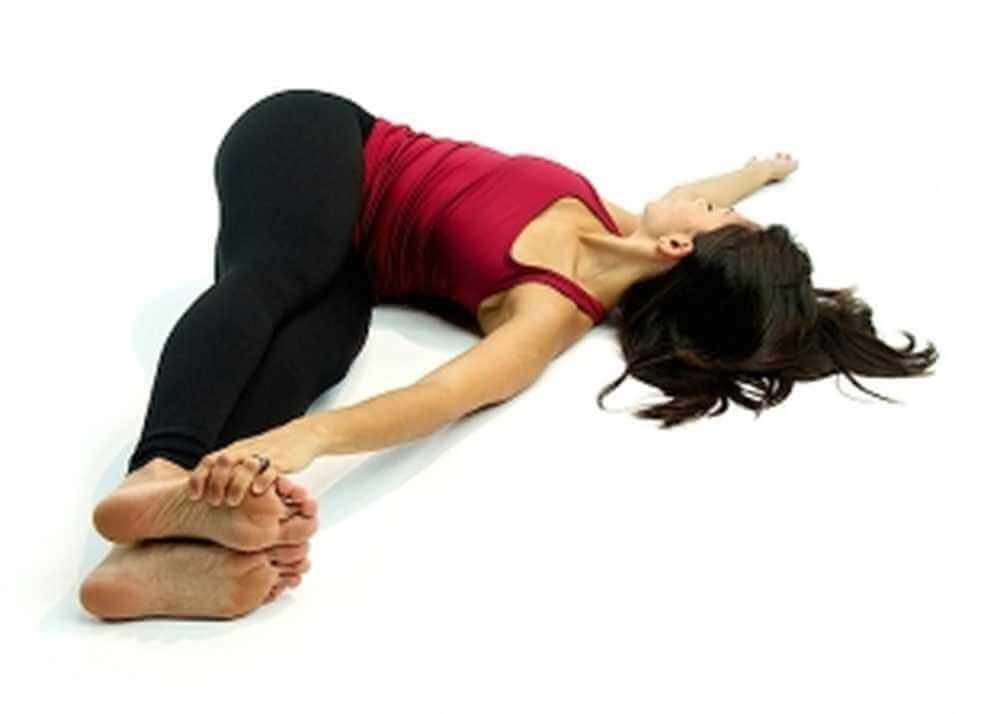
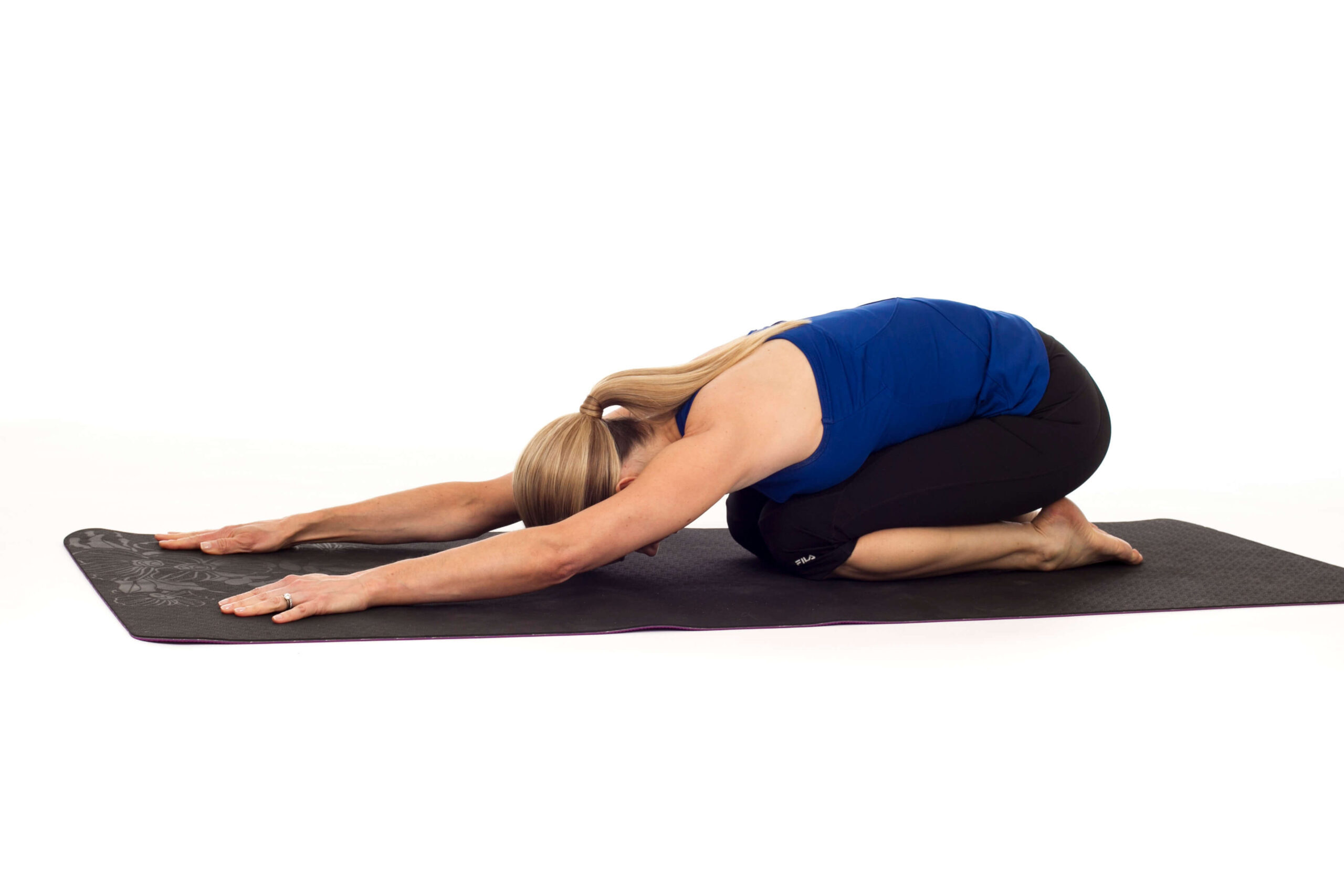
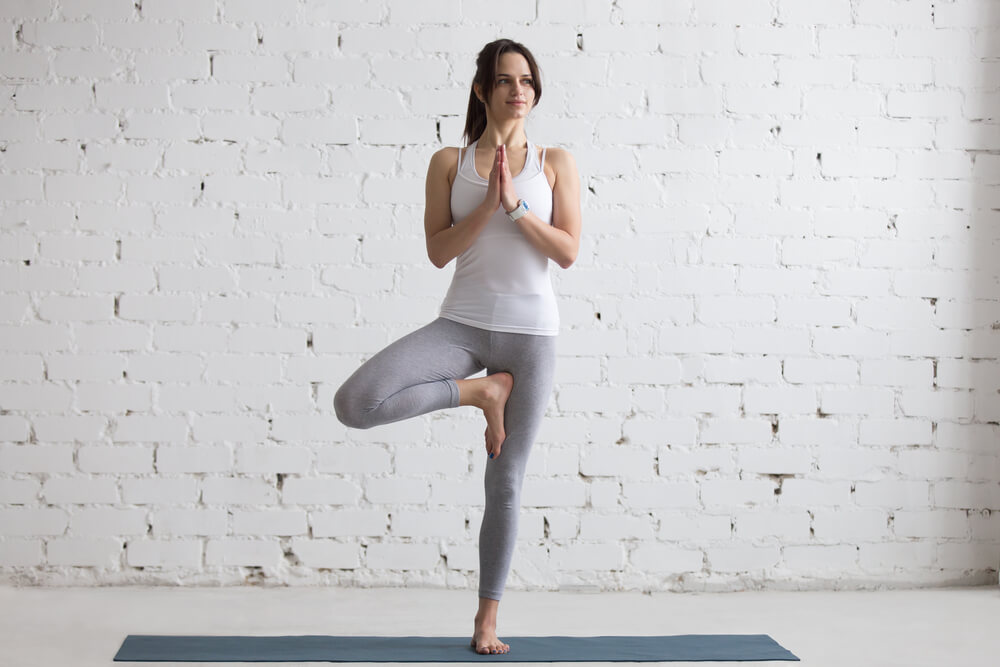
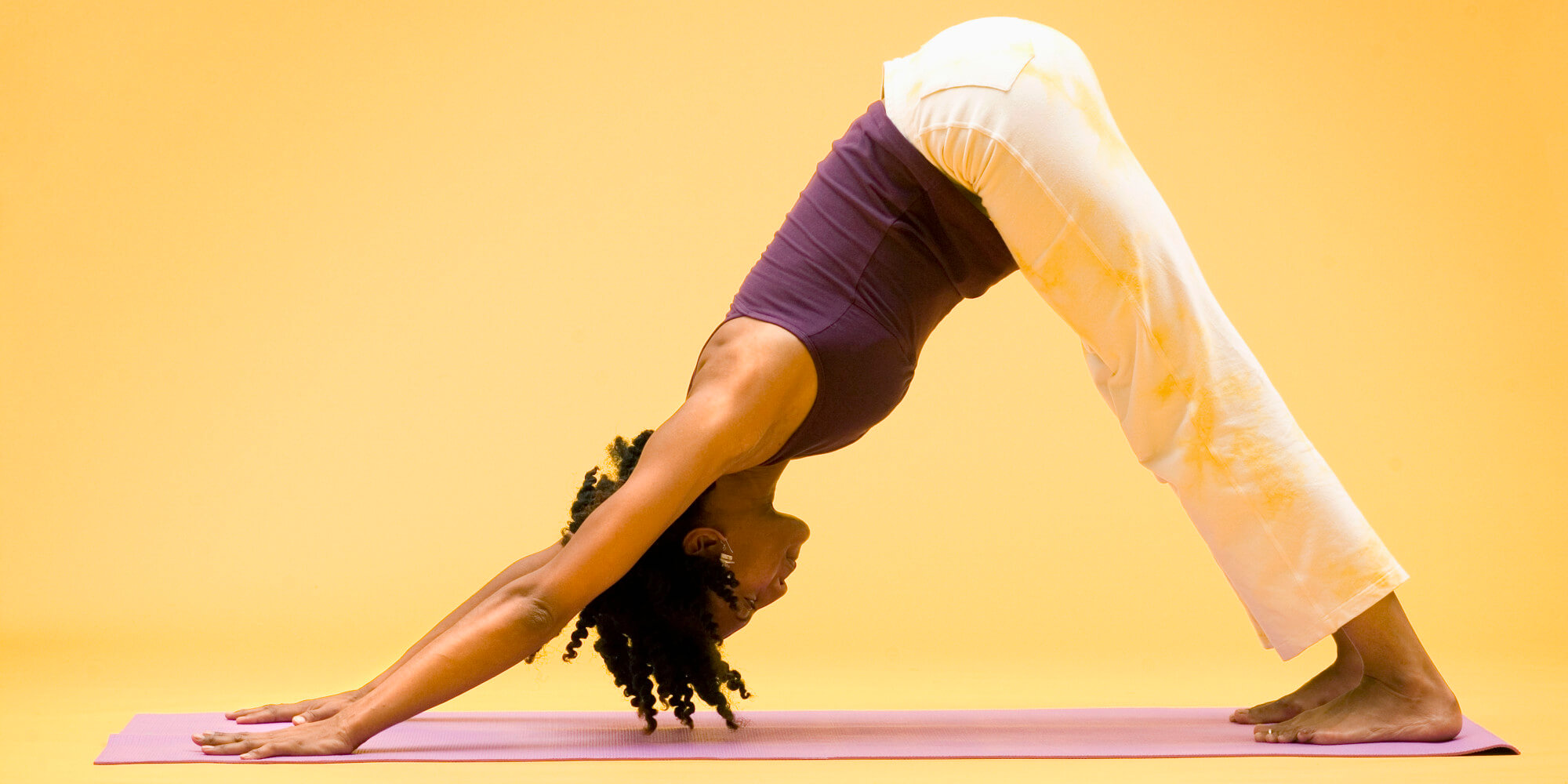
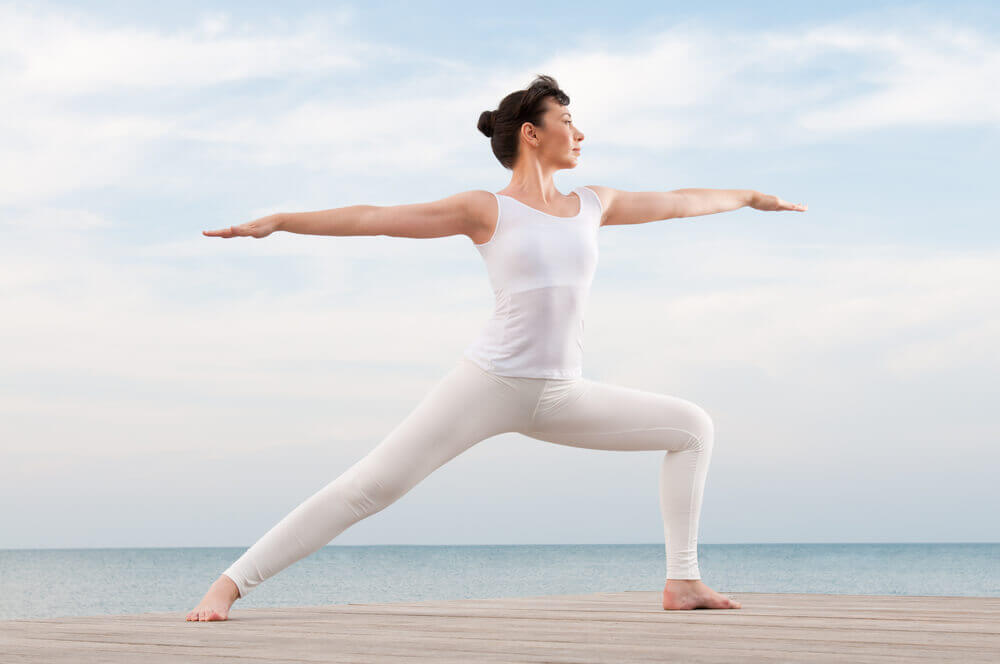
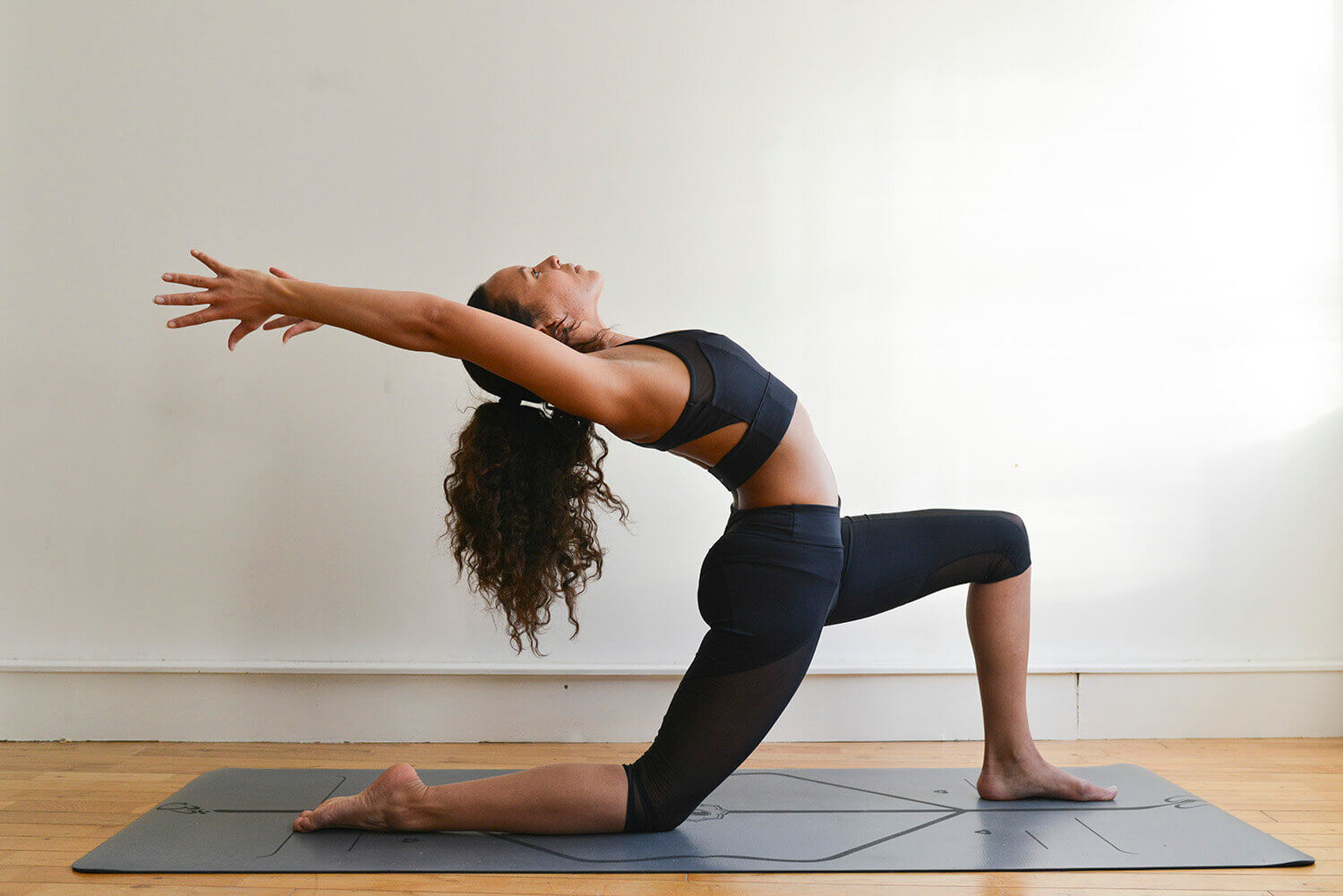
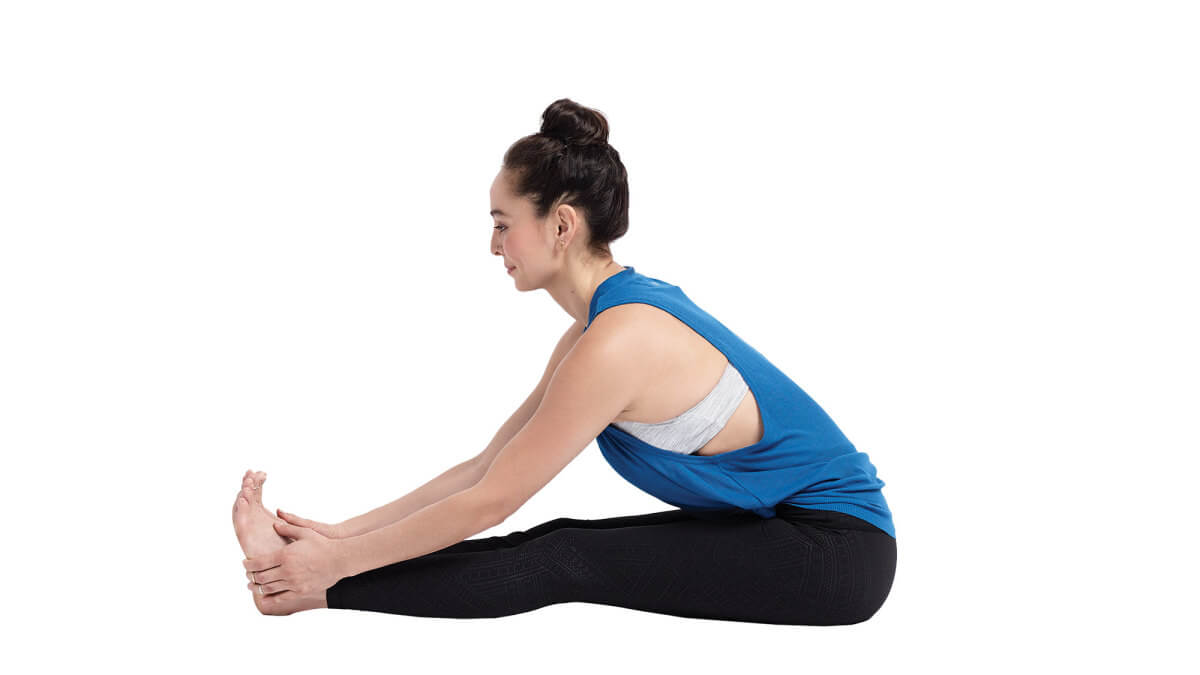
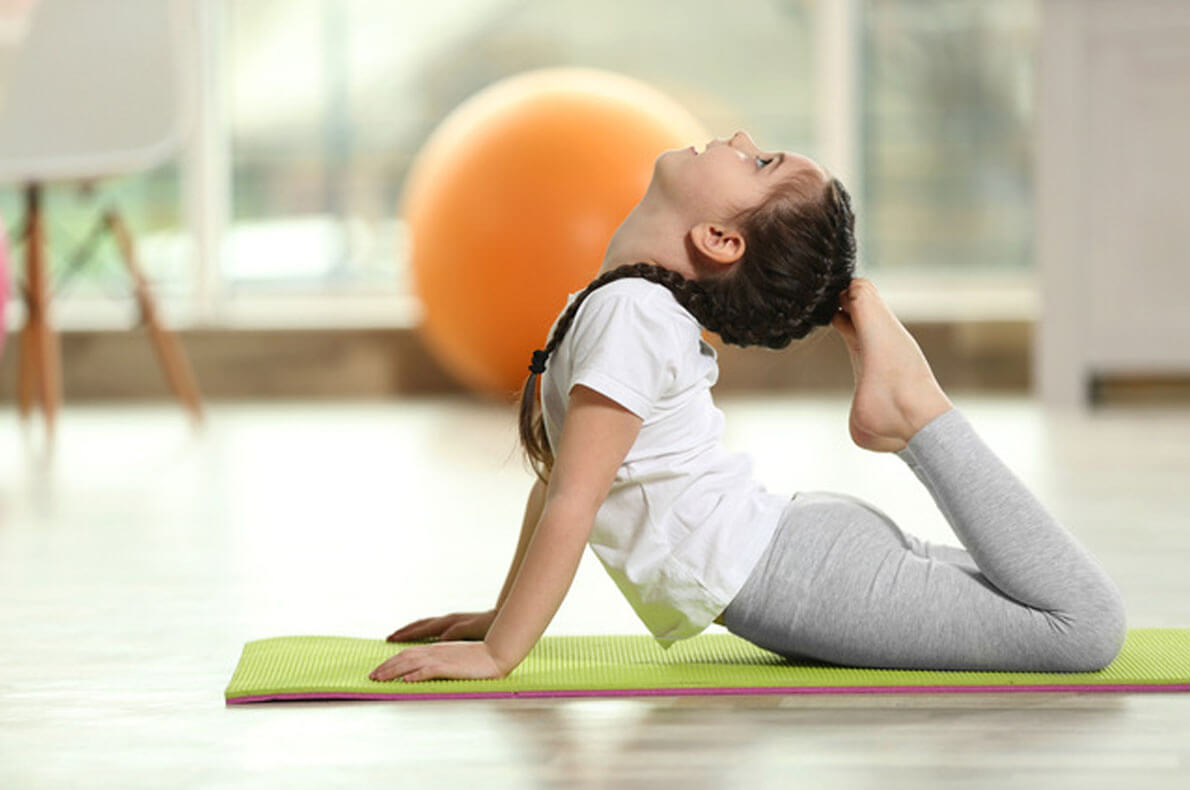
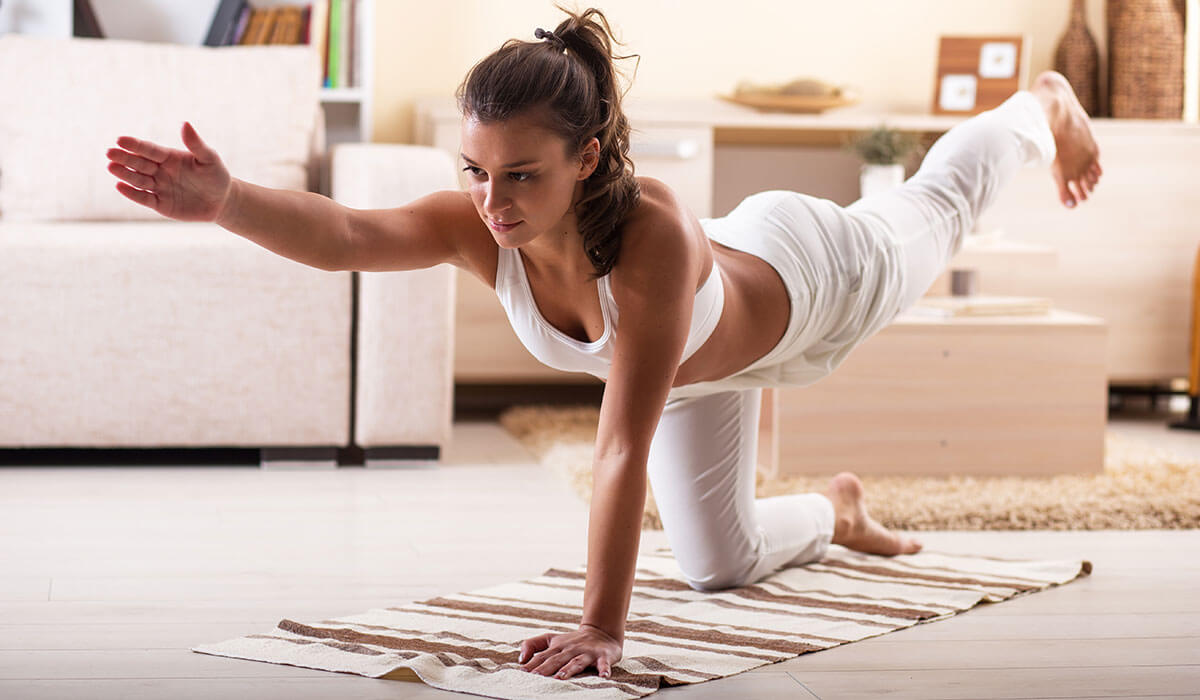
12 basic Yoga poses for beginners with namess:
12 Yoga poses for beginners with names: Want to start practicing yoga? Which yoga poses are the best to start practicing yoga? Discover the perfect yoga exercises to try with this ancient practice.
As you take your first steps in yoga, you may well feel overwhelmed by the sheer number of yoga postures that exist within this practice. As you do more and more yoga exercises you will end up adopting more and more difficult postures, but in the beginning, it is advisable to start with the easiest ones. Therefore, here we will introduce you to the most common yoga postures for beginners.
Main Yoga poses for beginners with names:
Below we will show you the most common yoga postures when starting with this practice. It is important to remember that if you are a beginner it is best to start with the easiest yoga exercises, as there are many postures that if not performed gradually can end up hurting you. Among the easiest Yoga poses for beginners with names are the following:
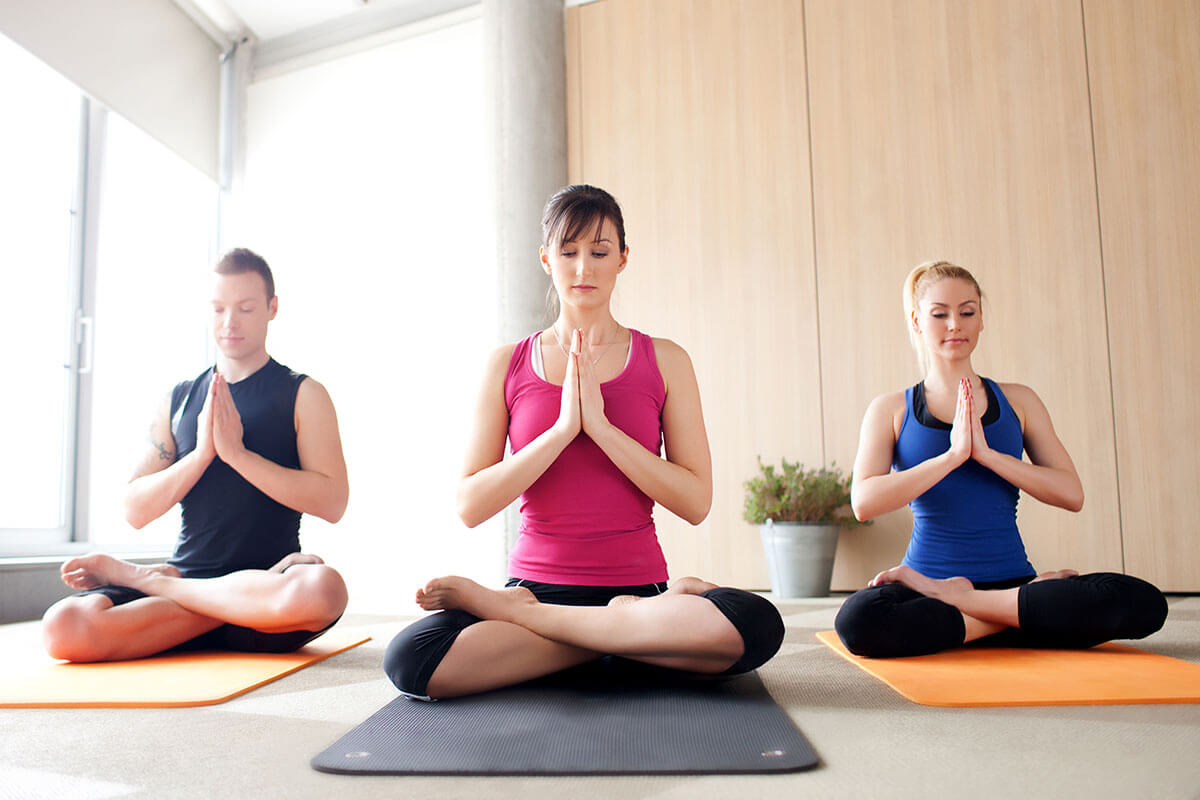





1-Downward facing dog (Adho Mukha Svanasana): It is very likely that if you have started to learn about yoga, the downward facing dog is one of the first postures you will be mentioned. This yoga posture is performed standing and is usually one of the first to be taught. Normally, beginners often make the mistake of leaning too far forward in this pose. The key to performing one of these yoga poses for beginners well is to keep the weight on the legs as well as the hips up. In addition, the feet should be kept parallel.
2- Mountain yoga Pose (Tadasana): The mountain pose may not be as famous as the dog pose, but in yoga, these positions are just as important. To do this yoga pose well you must keep in mind the concept of alignment, which is how the body parts are ideally arranged in each pose. Alignment in mountain pose draws a straight line from the top of the head to our heels, keeping the shoulders and pelvis aligned.
3- Warrior I (Virabhadrasana I): It is crucial to note in this yoga pose that the hips should face forward. To perform one of these yoga poses it may help to think of the two hip points as headlights and that they should be approximately parallel to the front. This may require you to adopt a wider posture.
4- Warrior II (Virabhadrasana II): Unlike Warrior, I pose, in Warrior II our hips should face the side of our mat. These two yoga postures are usually performed continuously. Unlike the Warrior I yoga pose, in this one you will have to rotate the back foot so that the toes are at an angle of about 44 degrees.
5-Reverse Warrior (Viparita Virabhadrasana): Keeping in mind the Warrior I yoga posture, incorporate a slight side bend. To achieve stability in this pose, it is important to bring the weight to the sole of the front foot, as well as engage the glutes and hamstrings. Focus your gaze toward the palm as it reaches overhead. Keep the front knee over the ankle as you sink deeper into the hips.
6- Garland Pose (Malasana): In this yoga posture we will have to squat. This exercise will allow us to benefit from an excellent stretch for the muscles around the pelvis, which becomes what is often called a ‘hip opening’ in yoga. If you find it difficult to squat, props can help: try sitting on a block or rolling a towel or blanket under your heels.
7- Half forward bend (Ardha Uttanasana): In one of these yoga exercises is usually done as part of the sun salutation sequence. In this yoga pose, the key will be to find out at what point our back is flat, something that will allow us to develop our body awareness.
8- Hands Raised Pose (Urdhva Hastasana): Keeping in mind the mountain yoga pose, you should root your legs into the ground while reaching for the sky with your arms. The result of the full body stretch performed in these yoga exercises is the best way to start marking the beginning of yoga practice.
9- Tree Pose (Vrksasana): This pose is a good introduction to yoga exercises that require good balance. This yoga pose is easy because if you see that you are starting to fall you can always get out of it very easily. One of the tricks you can keep in mind when facing this yoga pose is to focus your gaze on a specific point and try varying the positions of the feet to see what might work for you.
10- P plank pose: Although this yoga pose is called plank, the reality is that it is also a balancing exercise. The key to holding this yoga pose is core strength. This way we can work on both our stability and stamina.
11-Bridge pose (Setu Bandha Sarvangasana): Bridge pose is a gentle way to begin exploring spinal extension, also known as backward bending. It’s a good idea to start incorporating these types of movements because they improve both spinal mobility and counteract the effects of too much sitting. If you find this yoga pose too intense you can do it next to a block.
12 – Cobra pose (Bhujangasana): Cobra is one of the vinyasa yoga poses. To perform it correctly you can root into the feet, lengthen out through the crown of the head and widen through the clavicles as you lift the sternum. Another key is to anchor the pelvis to the ground before rising.
These are some of the main yoga poses that you can practice if you are a beginner or just want to try some of the benefits that this ancient practice has. Although these yoga exercises can be performed safely if you want to advance in the difficulty of the poses it is important to perform them with a specialist.
yoga poses for beginners pdf:
| Image | Product | Features | Available On Amazon |
Our Pick 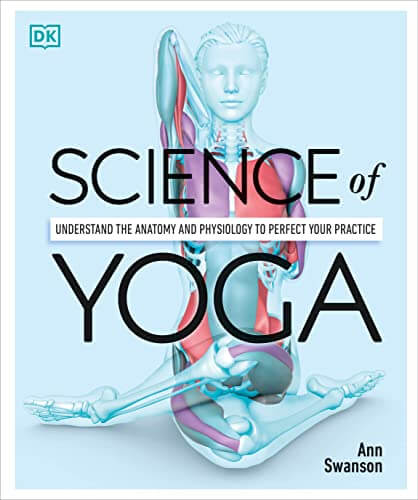 | Science of Yoga Pdf book: | Understand the Anatomy and Physiology to Perfect Your Practice (DK Science of) | |
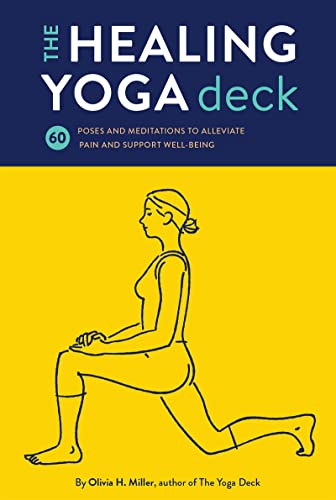 | The Healing Yoga Deck: | 60 Poses and Meditations to Alleviate Pain and Support Well-Being (Deck of Cards with Yoga Poses for Healing, Yoga for Health … Meditation and Exercises for Pain Relief) | |
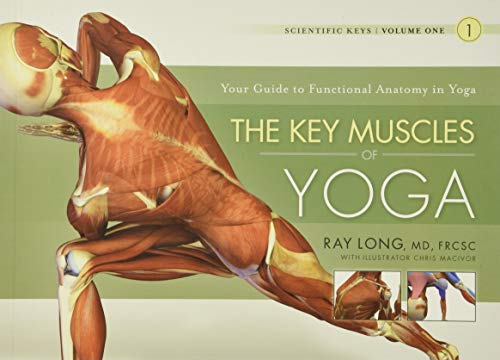 | The Key Muscles of Yoga: pdf book | The Key Muscles of Yoga: Scientific Keys, | |
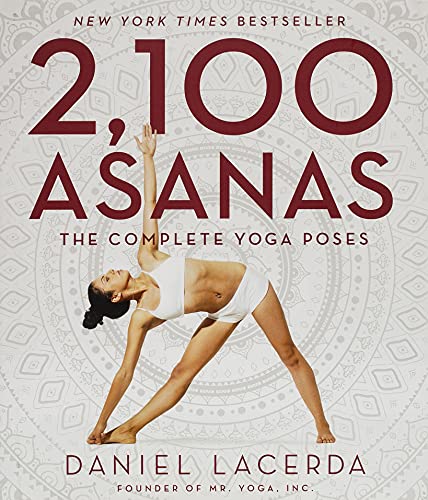 | 2,100 Asanas Pdf book: | 2,100 Asanas : The Complete Yoga Poses | |
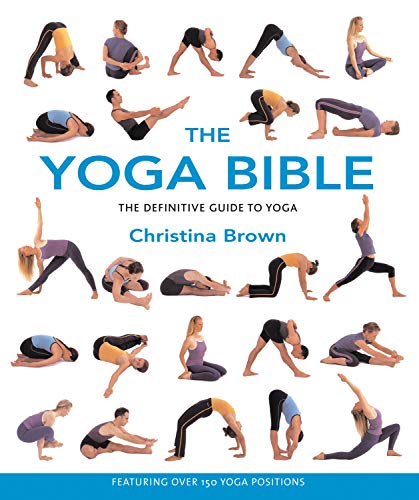 | The Yoga Bible Pdf book | Yoga brings not only a suppleness to the body but also a sense of spiritual and physical well-being to those who practice it. |
5 best yoga poses for beginners:
5 perfect yoga poses for beginners with names and pictures:
f you are a beginner in yoga, all the names of asanas poses and the different types of yogas can scare you. But like anything else, practice makes perfect! As you practice, you will become familiar with the different names of the poses and gradually assimilate them into your routine.
To help you build a solid foundation for your practice, we recommend the following 5 poses
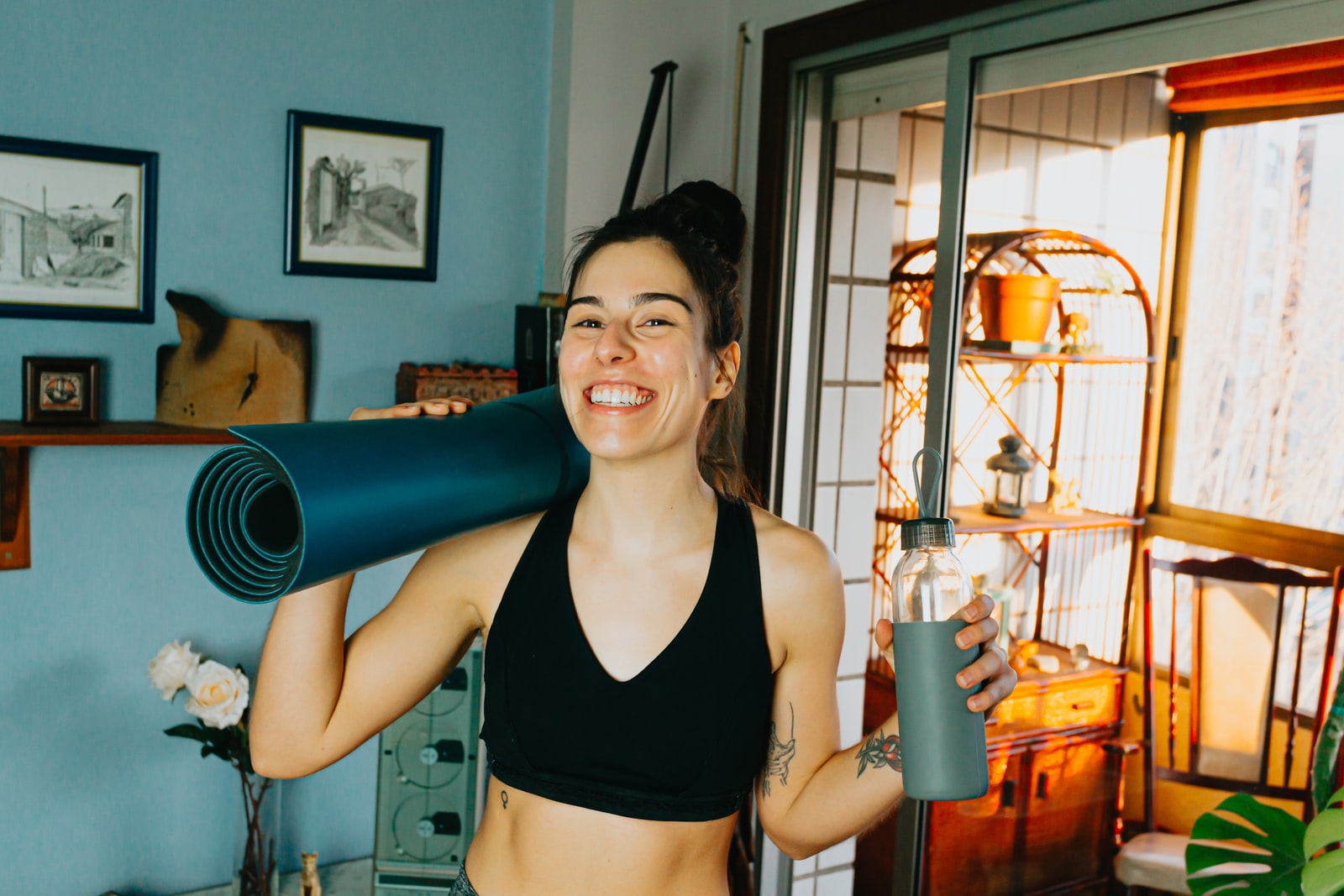
THE 5 Yoga poses for beginners with names ::
We have selected these 5 poses, because they are relatively easy to reproduce, but also very common in yoga classes for beginners
Child’s yoga pose (Balasana):
Often used as a beginning pose, or as a resting pose in transition between two sequences, the child’s pose is a good option for beginners – whether they are more or less flexible! This asana allows for a gentle, light stretch of the shoulders, lower back, ankles, hips, and inner thighs. It is a perfect pose to prepare for a deeper stretch later.
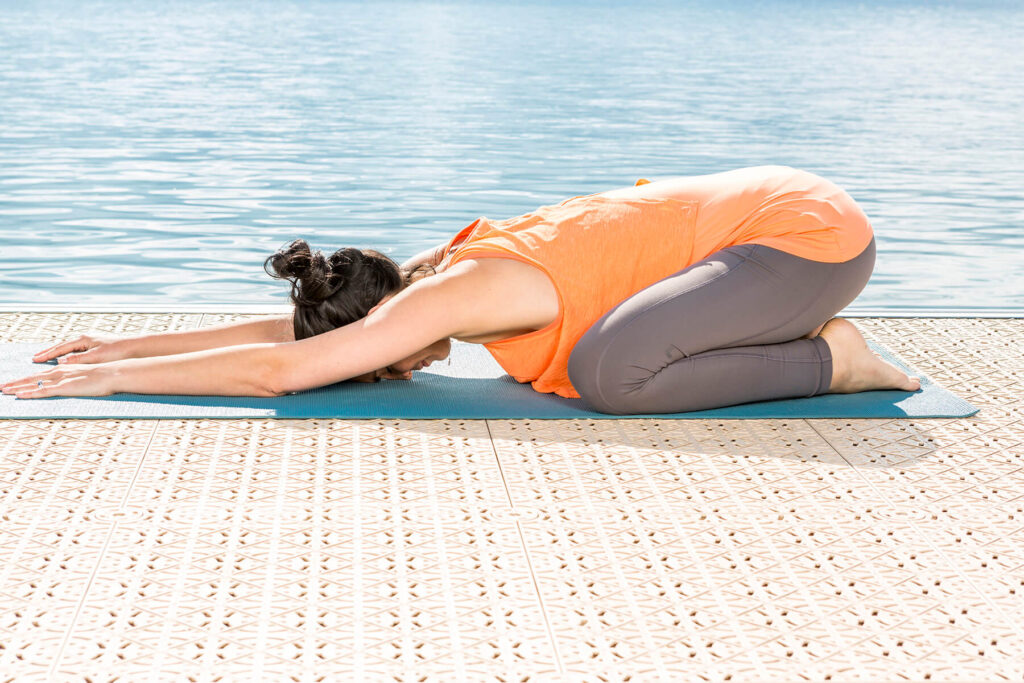
To perform this pose:
- Kneel on the floor, and let your hips slide over your thighs.
- Let your torso slide gently against your inner thighs, while your arms reach out in front of you, palms facing the floor.
- Rest your head gently on your mat or on a brick. Hold this pose for a few minutes while breathing deeply.
The benefits of the child’s pose:
- Stretches the ankles, hips, and inner thighs.
- Lengthens and stretches the spine.
- Soothes and centers the mind.
- Relieves tension in the back, chest, and shoulders.
The plank (Phalakasana) yoga pose:
The plank is a fundamental pose of yoga because it is the basis of many other more complex poses. It allows for strengthening of the wrists, the arms, and the trunk. It is essential to maintain a perfect alignment to succeed in this pose. Remember to check that your hips are well aligned with the rest of the body. and to engage the abdominals throughout this pose.
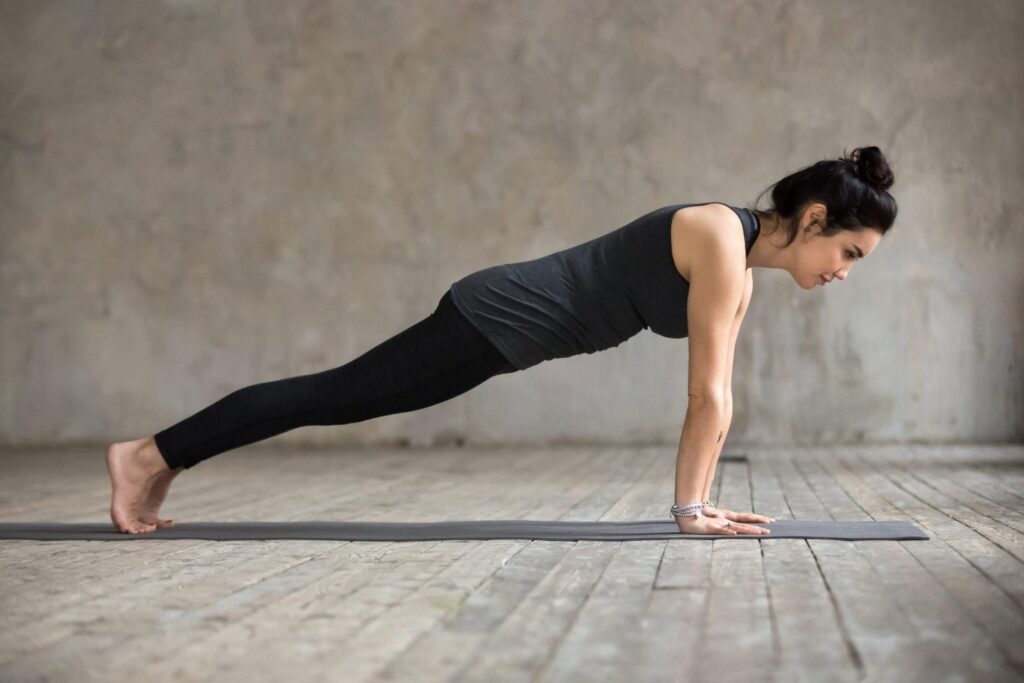
To achieve this pose:
- Start on all fours. Place your hands on the same line as your shoulders and align your knees under your hips.
- Engaging your triceps, lift your upper body so that your elbows are parallel to the wall behind you.
- Lift your knees and extend your legs behind you, hooking your toes. Engage your torso, tucking your tailbone and squeezing your inner thighs.
Benefits of the plank yoga pose:
- Strengthens the entire body, including the torso, chest, shoulders, back as well as legs.
- Improves your pose.
- Relieves back pain.
Downward Dog (Adho Mukha Svanasana) yoga pose:
When you think of yoga poses, the head-down dog is probably the one that immediately comes to mind. This asana is ubiquitous in yoga flow classes, but it is also often (and unfortunately) done incorrectly – shoulders slumped, back bent – which increases the risk of injury during your practice.
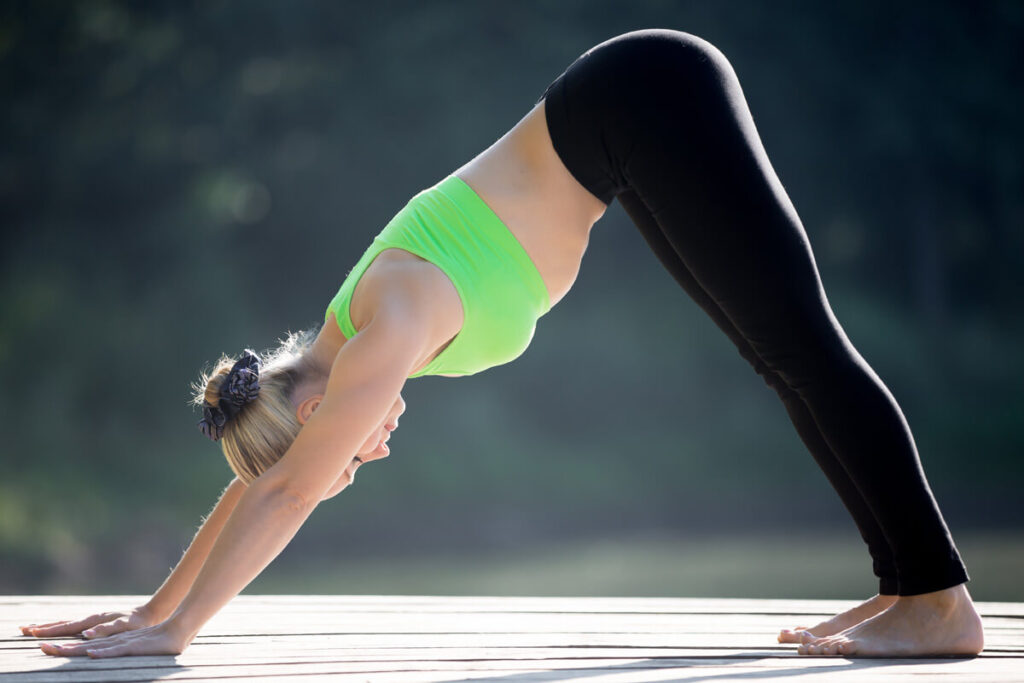
It is important to master this pose correctly from the beginning since you will use it constantly during the rest of your practice:
- Start in a tabletop position – on all fours – and place your hands on the same line as your shoulders.
- Turn your elbows slightly so that they are parallel to the wall behind you. Press your hands toward the mat to engage the torso.
- Raise your knees and hips in the air and stretch them back. Remember to align your shoulders with your hands and hips.
- Extend your spine and squeeze your inner thighs.
Benefits of Head Down Dog:
- Reduces stress and anxiety.
- Relieves tension in the neck, shoulders, and back.
- Lengthens your spine and improves your pose.
- Stretches shoulders and calves.
Warrior 2 yoga pose (Virabhadrasana II)
Warrior 2 is one of the most accessible poses for beginners because it invites you to become aware of your body and the importance of alignment in yoga. These two notions are fundamental and you will hear them often!
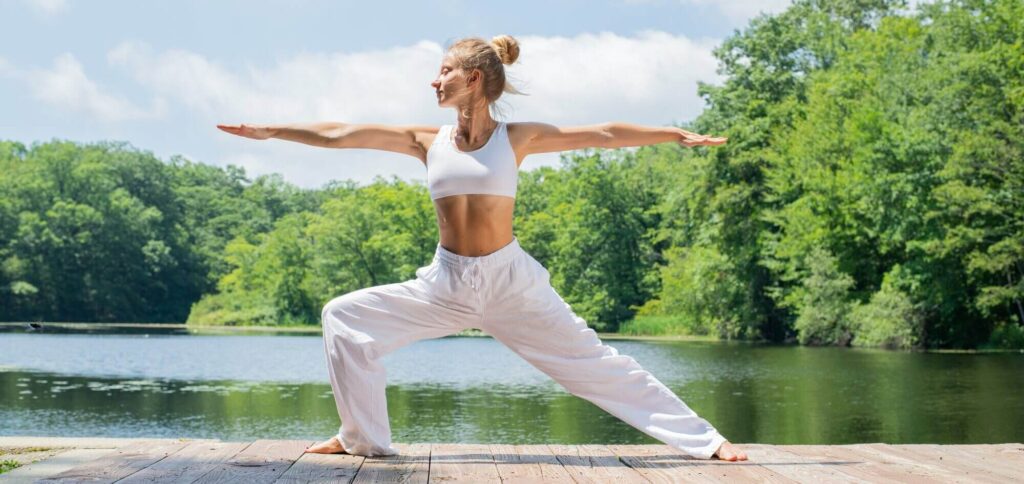
To perform this pose:
- Standing with your feet together, slowly slide your right leg to the side, aligning your knee with your ankle.
- Rotate your right foot to 45° – the left foot does not move – then raise your arms to shoulder level, parallel to the ground.
- Extend your arms as far as possible, engaging your abs, shoulders, and thighs. Hold this pose for a few minutes while breathing deeply.
Benefits of Warrior 2:
- Strengthens shoulders, back, arms and legs.
- Stretches the chest, shoulders, and neck.
- Opens the chest and hips
- Strengthens your balance and concentration.
- Increases circulation and energy.
Spinal Twist yoga pose (Supta Matsyendrasana):
This twisting pose opens the heart and helps release tension in the back while stretching the spine. It is the perfect stretching pose after a yoga session – or a long day of sitting or standing.
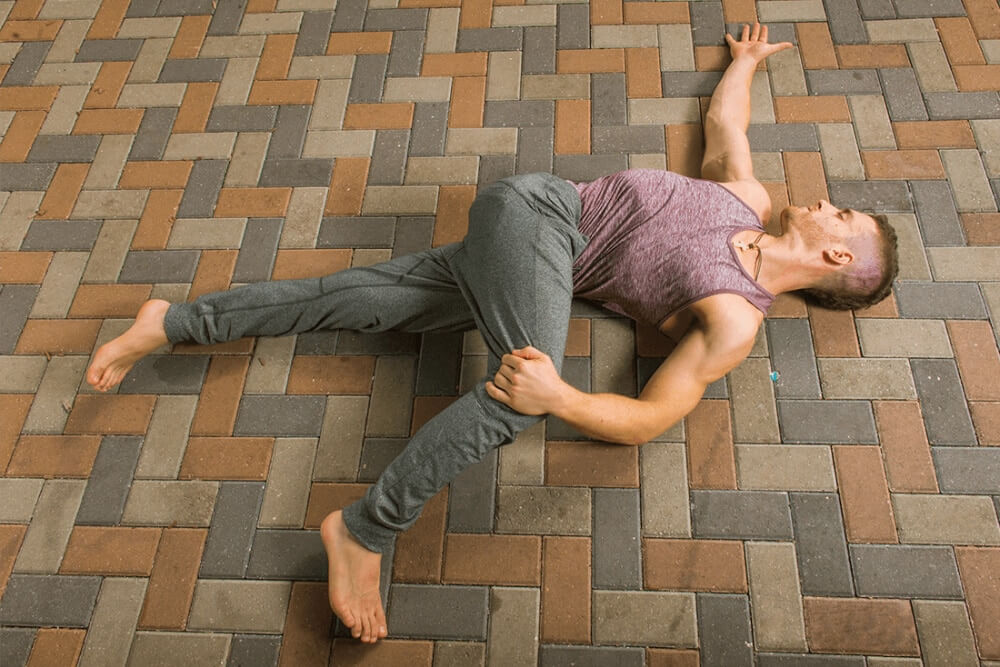
To perform this pose:
- Lying on your back, slowly roll your right knee toward your chest, holding it between your arms. The left leg remains on the floor.
- Release the arms from their embrace and place them on either side of your body. Slide the right knee to the left side of your body.
- Gently turn your trunk to the right side until you feel a stretch.
- Return to the center and repeat with the other leg on the other side of the body.
The benefits of the spinal twist:
- Stimulates the internal organs.
- Stretches the back and the spine.
- Soothes and relaxes the whole body.
standing yoga poses for beginners:
20 min Standing Yoga For Beginners | Back To Basics | Beginner Hatha Yoga:
Welcome to 20-minute Standing Beginner Yoga. In this practice we will do some of the most common standing yoga poses, staying a little longer in each pose so you have time to notice how your body feels in each pose, which muscles are working, and which muscles are getting a stretch.
You can do this practice without a yoga mat – just make sure you are standing on a surface where your feet won’t slide.
10-minute Morning Yoga for Beginners
Welcome To Your “Modern Day Yoga” Youtube Channel By Sarah Beth Yoga Where You Can Find Clear & Fuss-free Yoga Videos Ranging From Short 10 Minute Yoga Routines To Longer 30 Minute Yoga Practices For All Levels To Help You Get Stronger, Happier & Healthier.
yoga for kids:
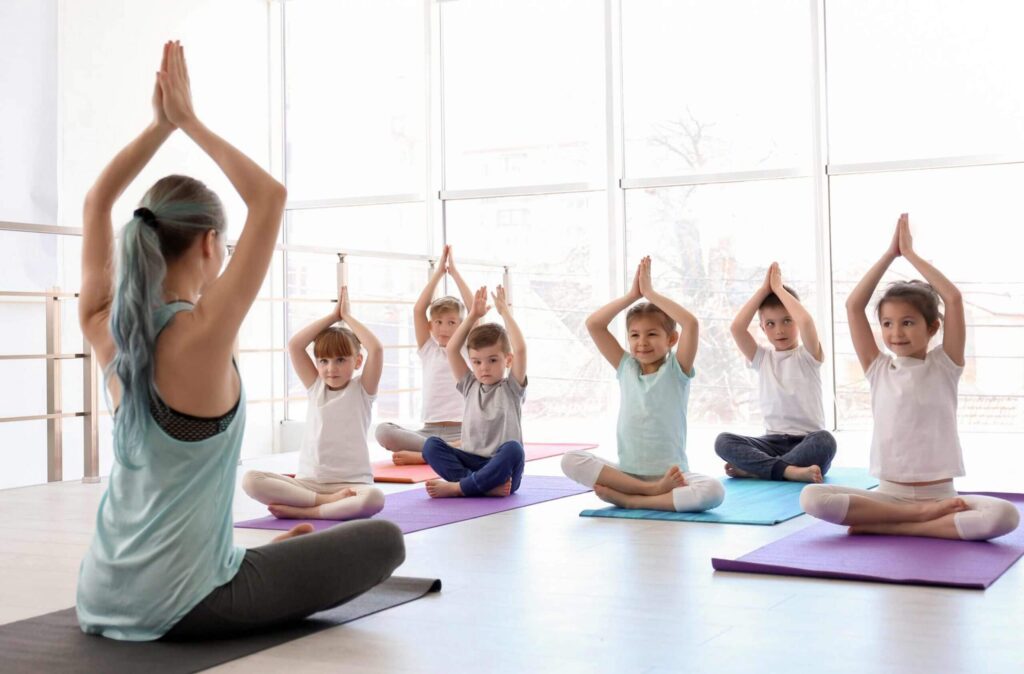
Yoga For Kids – Activity To Play And Relax With Children:
Parents are looking for activities for their children that, besides having fun, have positive benefits for their physical and mental development, and their health. Yoga for Children can be a good alternative to combine play with relaxation, concentration and balance. We Tell You More About Yoga, This Sports Discipline That You Can Practice As A Family, Both At Home And Outdoors.
When and How Children Can Practice Yoga:
Originally from India, the word Yoga means ‘union’, union first with oneself (the child meets himself, learns to know himself), and then with others (children learn to relate and communicate with their environment).
However, Children’s Yoga could also be considered a great way to unite the game, since children have a great time while they carry it out, with relaxation or concentration, which is what is achieved with the continuous practice of this discipline.
As it happens with another type of sport, children’s Yoga is a great way for children to exercise and, in this case also to relax, while keeping them entertained and having a great time.
Experts agree that the best age for children to get into Yoga exercises is the age of 4. At that age, the little ones already know perfectly well what can be expected and wanted of them and already have the ability to perform and control certain movements of the body.
At that age, for children, the practice of Yoga is a playful activity. However, thanks to Yoga they manage to forget the possible situations of pressure or stress that appear at school or home and relax, adopting a calm attitude, reducing tensions and facilitating their concentration and self-control. Yoga also promotes their creative potential and enhances their talents.
The Benefits of Yoga For Children:
Yoga is a recommended activity for all children. The search for balance and harmony is a good basis so that, in the future, the little ones enjoy a happy and healthy adult life.
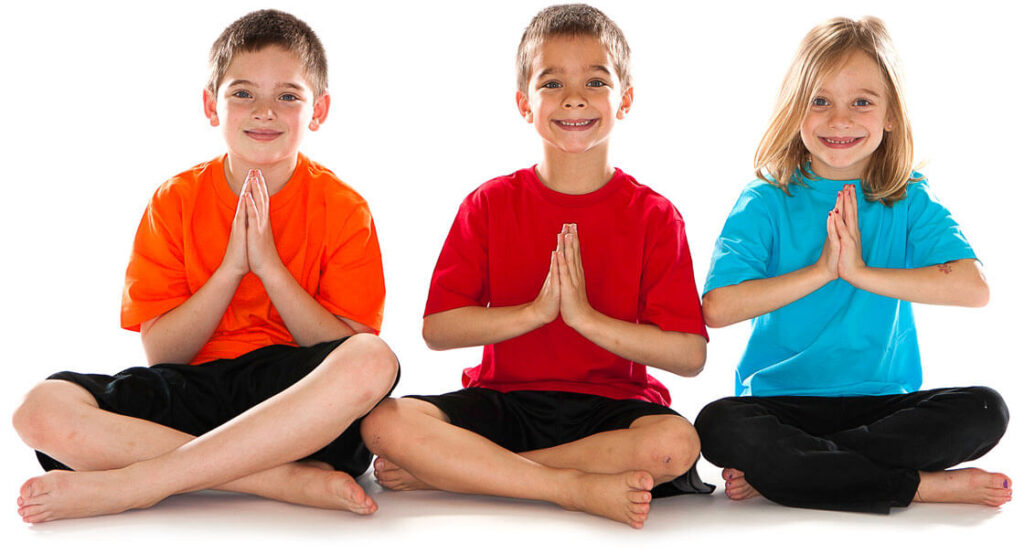
For the restless or active child as well as for the shy or embarrassed, Yoga helps to channel their energy. It will help the more active learn to relax and concentrate more, while also encouraging quieter children to lose their fear of others and open up to the universe around them.
Yoga is an excellent tool for children to have a more active life since it activates them and is great entertainment to avoid the excessive use of screens in leisure time.
Yoga, Adapted To The Personality Of Each Child:
Yoga For Children: Consequently, depending on the temperament of each child will have to plan Yoga classes with some types of exercises or others. You can not plan a standard practice of Yoga the same for all types of children, but before we have to study and analyze the temperament of each.
We must take into account various characteristics that will then influence the formation of a personality and a normal or deviant physical development. These characteristics are:
- Level of activity of the child: frequency and speed of its movements.
- Regularity Or Irregularity In Their Physiological Functions: Sleep, Hunger, Etc.
- Reaction to new experiences such as a new bedroom or being with unfamiliar people.
- Minimal Force or Stimulus Needed to Get Your Attention to Perform a New Movement or Activity.
- Expansion Energy In Which You Express Your Emotions, Moods, Desires, Illusions, Etc.
- The ease with which your attention is diverted from one activity to another by some peripheral stimulus.
- Time of uninterrupted attention to a simple activity such as watching television or to a posture.
For all these reasons Yoga is a highly recommended activity for children, a game that promotes their development in all senses and helps them to relax, concentrate and lead a calmer life now and in the future, always maintaining a positive attitude.
the top 7 benefits that help children:
Yoga helps stabilize psychophysical conditions and develop cognitive and social skills. there are many benefits of yoga for kids. we talk about the top 7 benefits that help children:
Correct posture: how often do you see your child with a hunched back while eating or doing homework? To avoid severe back pain, practicing yoga can help children achieve correct posture.
Developing self-confidence in their bodies: Your child must learn to accept their body from a young age in order to love themselves.
Respect for themselves, others, and the environment: yoga is not only a physical exercise but also a mental one that helps to have respect not only for oneself but also for the planet and the people around us.
Understand when you need to relax: as we get older, we tend not to take breaks in our lives (mainly because of technology). Yoga will help your child realize that spending some time with themselves is essential for their health.
Expressing emotions: through this activity, it will be easier for your little one to let off steam and get rid of any negativity.
Reducing stress and anxiety: it is very easy to be stressed or anxious because we are confronted with thousands of daily stimuli, from the Internet, the media, school, work, etc. And that includes children! The practice of yoga is a form of meditation that helps you find the concentration that allows you to better manage the problems of your daily life.
It stimulates the ability to learn: it develops their curiosity, an important skill that can be very useful in the future.Mindfulness
Yoga poses for kids:
Research says that yoga exercises can help children cope with stress and have a balanced life and mental health (1). A child does not need any yoga skills to start practicing yoga. They just need to start, and yoga will become part of their life. It keeps them active, balances their body, mind, and soul, and helps them focus on their life.
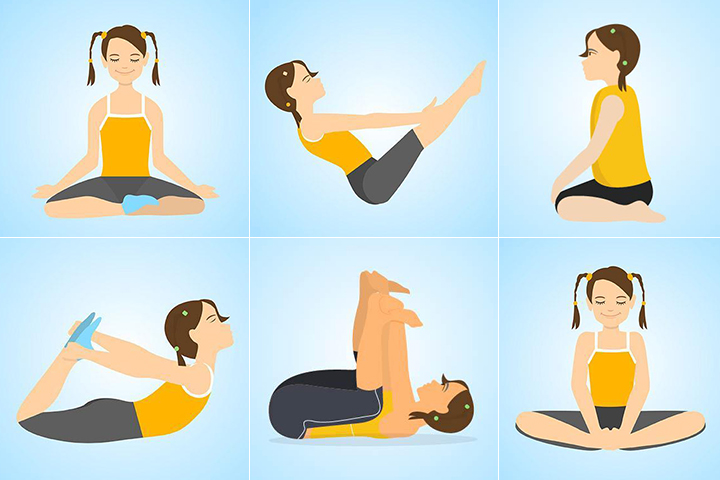
MomJunction helps you introduce yoga to your kids, as we talk about the benefits of yoga for kids and share instructions for some simple asanas (yoga poses) to get started.
It is a good idea to start teaching yoga to children at a young age, as it is not only beneficial for their physical growth, but also for their emotional and general well-being. It also helps children develop interpersonal skills, stress management, and mindfulness, skills that may be useful in adulthood.
Yoga can be helpful while treating many physical and emotional problems. It could be used as a tool to bring balance to life. Some of the possible health benefits of yoga are :
Improves body balance, strength, and aerobic capacity.
It helps reduce chronic pain such as muscle aches
Improves sleep quality
May reduce the release of stress hormones such as cortisone and therefore is effective in reducing stress, anxiety, and fatigue
Works on the child’s classroom behavior, concentration, and academic performance
Improves quality of life by providing emotional balance, as yoga is a non-competitive activity
Helps children improve resilience, mood, and self-regulation skills
Six months of yoga, including meditation, asana, and pranayama (breathing exercises), have been shown to reduce body weight, improve endocrine function and memory
Yoga has countless benefits to offer. Let your child start with the basic poses and realize the beauty of this practice. There are different styles of yoga, including body postures, breathing exercises, and meditation. So, when teaching yoga to children, you may want to consider focusing on the movement and how to make it interesting for them at first. Once you manage to get them interested, consider adding breathing and meditation.
You should also explain to your child that they may reap the benefits of yoga over time and that to do so, they need to practice it regularly.
To get started, here are some easy yoga poses you can try to teach your children.
15 Best Yoga Pose for Kids with names and pictures:
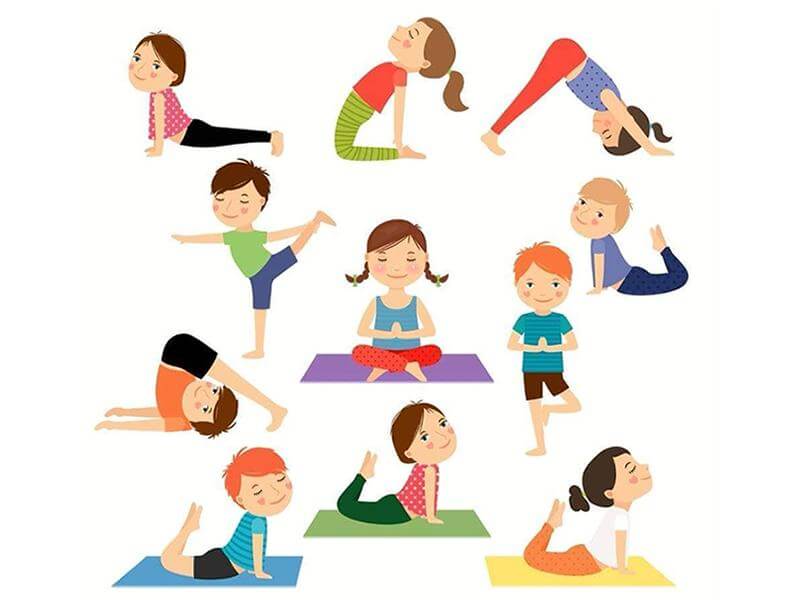
Yoga does not require a huge venue or elaborate equipment. It can be practiced in the backyard, at home or at school, with a simple yoga mat.
15 yoga poses for kids; they are easy, quick and safe for a daily practice.
1 – Bridge pose (Setu Bandha Sarvangasana):
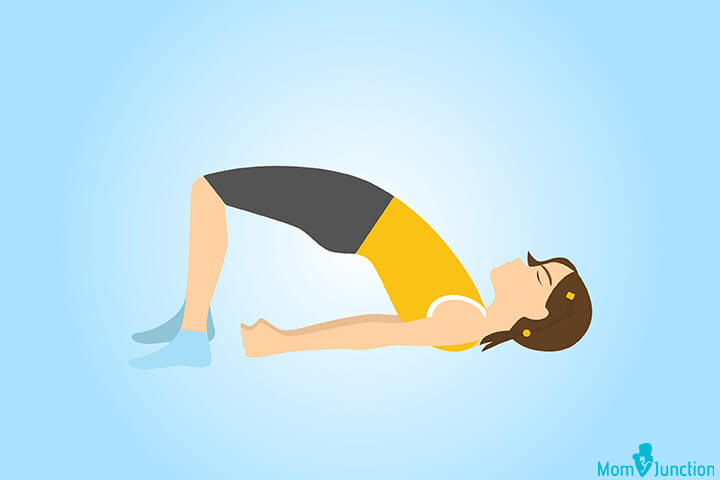
This rejuvenating backbend gives a good stretch to the spine and thighs.
How to do it:
Lie on your back.
Bend the knees a little and keep the feet flat on the floor, hip-width apart.
Knees and ankles should be in a straight line.
Place arms in a resting position at the side of the body, with palms facing down.
Take a deep breath and lift the lower, middle and upper back off the floor.
Balance the body so that the arms, shoulders and feet support the weight of the body.
Keep the buttocks tight.
Have fingers intertwined and hands pushed toward the floor to help lift the torso higher?
Let your child hold this pose for as long as he or she is comfortable and breathe slowly while in the pose.
Exhale and release.
Possible benefits: Stretches and opens shoulders, thighs, hips and chest; strengthens back and hamstrings; increases spinal flexibility
Warning: If your child has difficulty getting his or her pelvis off the ground, slide a solid bolster under the sacrum to rest the pelvis. If your child has neck or shoulder pain, seek professional help to refine the steps.
2 – Tree yoga Pose (Vrksasana)
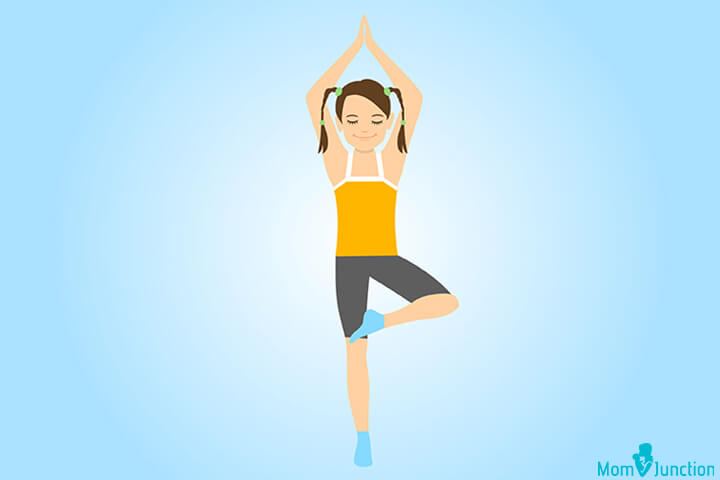
Vrksasana teaches your child the grace of a tree, to stand up straight and maintain balance.
How to do it:
Begin the pose with mountain pose, in which the legs are straight, hands at the sides, back straight and thigh muscles firm.
Lift the right foot with the knee outward.
Place the right foot on the inside of the left thigh in a position where it is comfortable.
Bring your hands together over your head.
Look at a spot about five feet away.
Hold the position for 30 seconds to one minute.
Return hands to chest, then lower right leg.
Repeat on the left leg.
Possible benefits: Improves balance and concentration; strengthens thigh muscles, calves and ankles while stretching legs and torso
Warning: If your child is unsteady at first when trying to maintain his or her posture, you can have him or her hold his or her back against a wall.
3- Cobra yoga Pose (Bhujangasana):
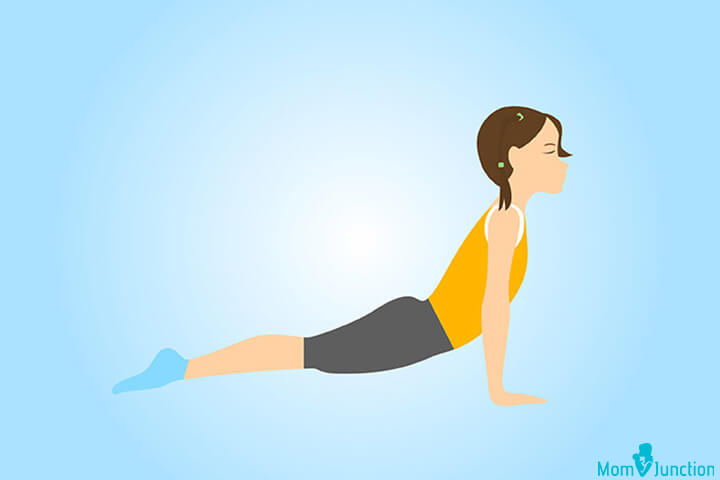
Stretching could promote back strength, abdominal strength and strength.
How to do it:
Lie on your face with the tips of your feet flat on the floor and palms on either side of your body.
Pull the shoulders slightly back toward the spine.
Work the abdomen throughout the exercise as it helps protect the lower back.
Lift the body into a cobra pose while keeping the chin up. Use your hands for support, but do not apply unnecessary pressure.
Hold the pose for 15 to 30 seconds, before gently releasing the body to the floor. This is a good morning yoga pose to practice daily for children.
Possible benefits: Strengthens the spine; stretches the chest, shoulders, abdomen, and buttocks; stimulates the abdominal organs and releases fatigue and stress; may be good for managing respiratory problems such as asthma.
Warning: Have your child arch the back as much as the body can handle. Every child has different flexibility, so let him or her go slowly.
4-Cat yoga pose (Marjaryasana):
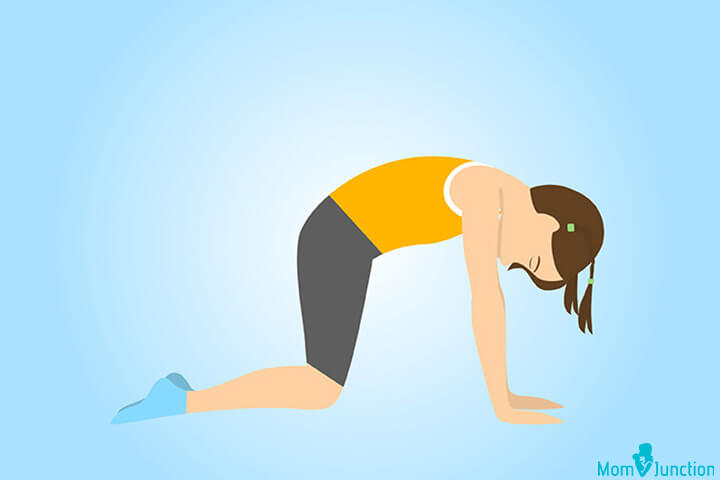
Cat pose is a gentle kneading for the back and trunk.
How to do it:
Assume a position on a table using the hands and knees.
The knees should be directly under the hips, and the toes curled.
Wrists, elbows and shoulders should be straight and perpendicular to the floor.
Center the head in a neutral position, eyes looking down at the floor.
With an exhalation, arch the spine toward the ceiling.
Release the head toward the floor without forcing the chin toward the chest.
Return to the initial position on the table while breathing in slowly.
Possible benefits: Relaxes and stretches the spine, neck, torso and abdominal organs.
Warning: If your child has difficulty rounding his or her upper back, place a hand above and between the shoulder blades for support.
5-Bow yoga pose (Dhanurasana):
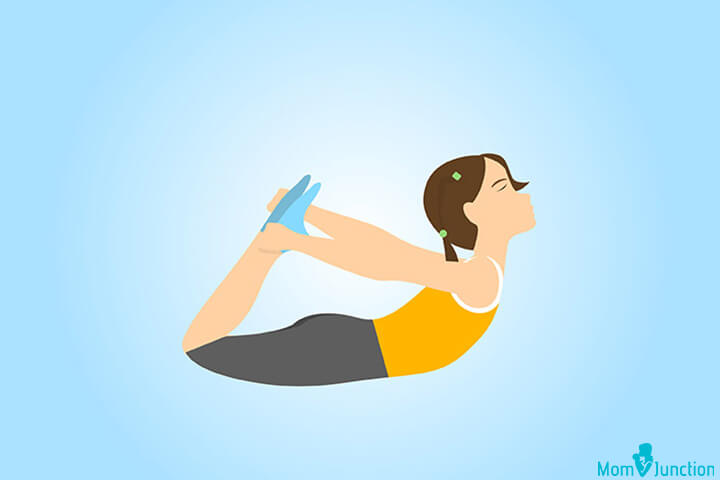
Bend the back like a bow and open the chest and shoulders with Bow Pose.
How to do it:
Lie flat on your stomach, keeping your arms straight along the sides of your body and your head resting gently on the mat.
Inhale and bend your knees, bringing your feet toward your hips.
Grip the ankles using both hands.
Lift shoulders, torso, legs and hips off the floor while looking straight ahead.
Hold for four to five breaths, then lower the knees and release the feet.
Release onto your stomach.
Possible benefits: Stretches and strengthens the back, shoulders, chest and legs; provides flexibility to the hip flexor function and regulates the digestive system
Warning: Bow pose involves a lot of stretching, so if your child feels heavy in the lower back, keep the posture lower until it is comfortable to stretch. Help him/her hold the ankles in step 3 and lift the body in step 4.
6- Frog pose (Mandukasana):
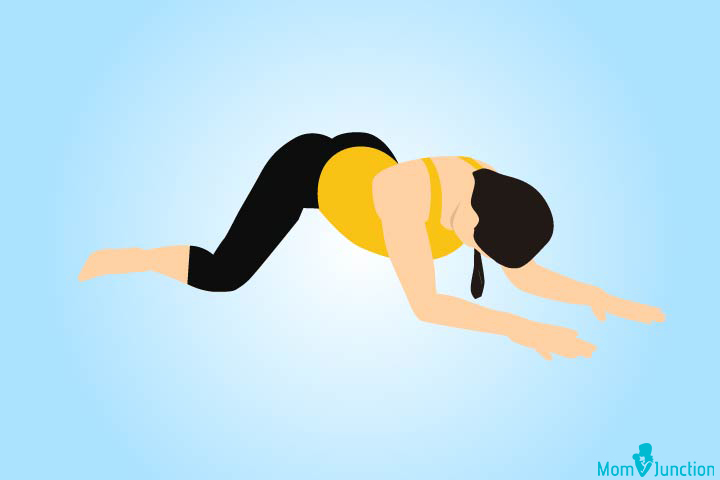
This pose may help with sprains or back pain.
How to do it:
Start by getting on the floor on your hands and knees.
Position the knees a few inches apart and place the feet just behind the knees.
Place palms just below shoulders with fingers facing forward.
Look down and focus on a point between your hands.
Now push the tailbone back. This will stretch the spine. This position is known as the table position.
Slowly move the knees out to the sides. Then align the ankles and feet with the knees in a straight line.
Begin to slide down while keeping palms flat against the floor.
Exhale and continue to push the hips back until a stretch is felt.
Hold this position for three to five breaths.
Return to the tabletop position.
Possible benefits: Stretches hips, thighs and spine
Warning: If your child has pain below the knees or elbows, place a folded blanket for support and strength. Do not let him stretch beyond his comfort level.
7- Easy yoga pose (Sukhasana):
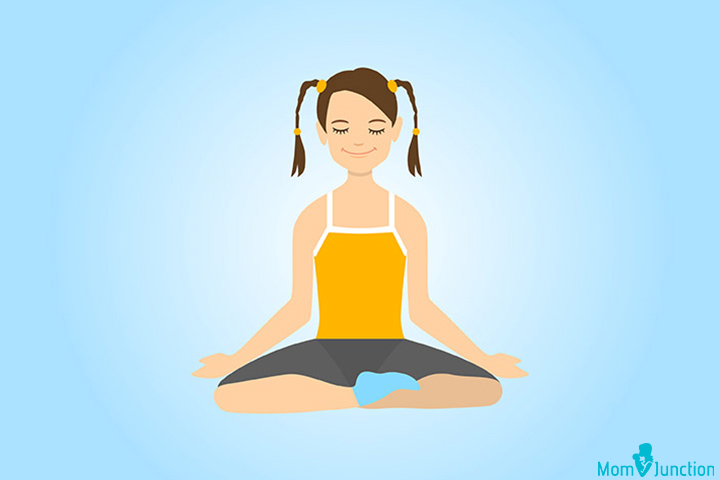
This is the simplest of all the poses a child can try.
How to do it:
Sit upright with legs crossed.
Hold hands on knees with palms up.
Balance weight on seat bones.
Keep the head, neck and spine aligned throughout.
Widen the spine but do not stiffen the neck.
The feet and thighs should be relaxed.
Hold this posture for one minute.
Release and change the position of the crossed legs.
Benefits: Good for the back, thighs and hips; gives a stretch to the knees and feet; and helps cancel anxiety and stress.
Warning: If your child’s hips are tight and he/she has trouble sitting flat, prop him/her up with a folded blanket or firm pillow under the hips.
8- Butterfly pose (Baddha Konasana):
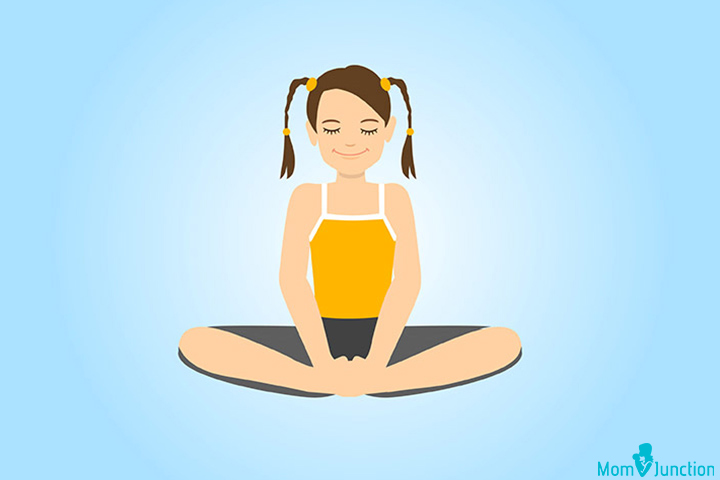
A pose that makes your child flutter like a graceful butterfly, would offer valuable benefits.
How to do it:
Sit with the spine straight and the legs spread straight.
Bend the legs so that the feet touch. Hold them with your hands.
As you exhale, gently move the thighs and knees in a downward motion.
Then begin to flap your legs up and down, like the wings of a butterfly.
The flapping should be slow at first, then speed up. Breathing should be at a normal rate.
Gradually decrease and then stop.
Gently release the posture by breathing out.
Possible benefits: Stretches thighs, knees and hips; regulates bowel and intestinal transit; for girls, helps to have an easy and painless period.
Warning: If your child has a knee or groin injury, keep a blanket under the thighs to avoid pain or soreness.
9- Body pose (Savasana):
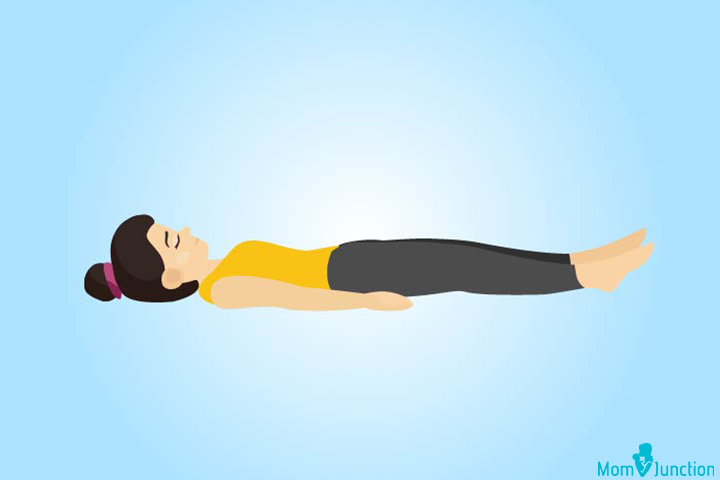
Although this yoga pose seems effortless, it could be difficult as it requires patience.
How to do it:
Lie on your back with your legs straight and your arms at your sides. Arms should be at least six inches away from the body.
Keep your eyes closed, and palms facing up.
Keep feet drooping open.
Breathe normally while resting body weight on the floor.
Exhale slowly while relaxing and de-stressing all parts of the body.
This is the best relaxing yoga pose for children.
Possible benefits: Keeps heart rate and blood pressure down; less muscle tension; low metabolic rate; helps reduce insomnia, anxiety and fatigue; improves productivity, memory and concentration.
Warning: Often the body gets cold, and you may feel relatively cold after holding this posture. Have a sweater or a pair of socks around your child in case he or she gets cold
10- Chair pose (Utkatasana):
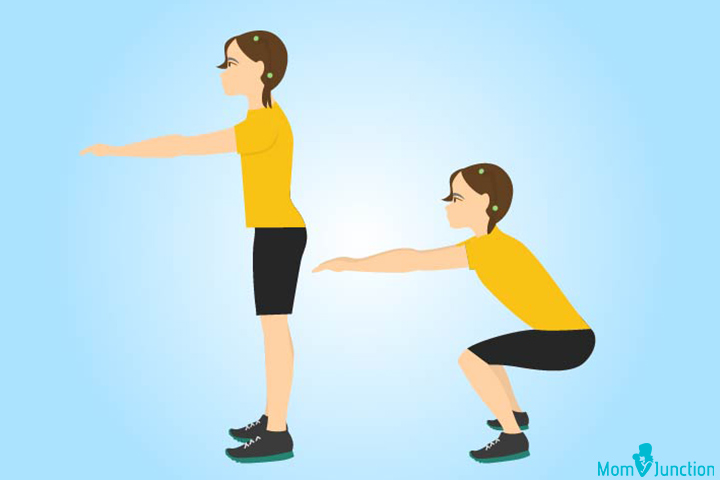
Chair pose is a workout for the legs, arms, and core, and is considered one of the most constructive yoga poses.
How to do it:
Inhale and raise your arms above your head.
Bend the knees forward as you exhale; the thighs should be parallel to the floor.
As you do this, your knees will throw forward slightly.
Raise your arms and stretch them straight out.
Keep the tailbone down and the lower back long.
Keep your breathing steady and easy throughout the session.
Keep your eyes forward.
Hold this pose for as long as you like, but no longer than one minute.
Possible benefits: Works thigh muscles and ankles; tones shoulders, hips and spine; regulates digestive system and heart function.
Cautions: If your child suffers from headaches or insomnia, do not perform this asana.
11- Hero Pose (Virasana):
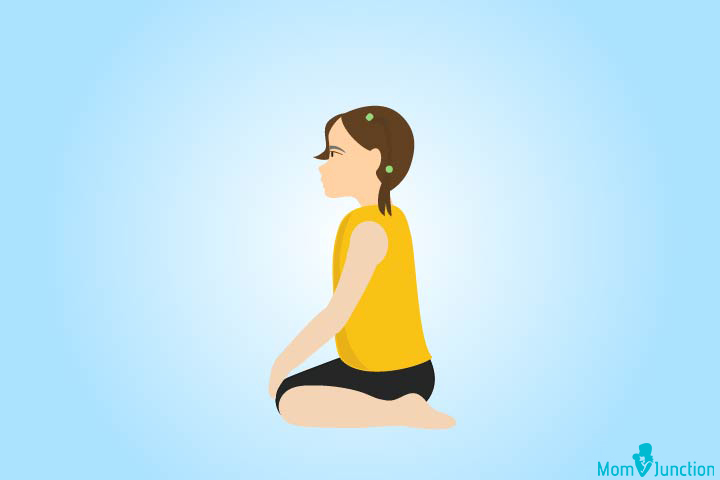
This pose could be the balm for your children’s tired legs.
How to do it:
Sit with knees together and feet hip-width apart.
Sit on your heels with your heels touching your hips.
Hands should rest on knees with palms up.
Straighten the spine and drop the shoulders down and back a little.
Relax the center while taking deep breaths.
Hold the posture as long as it feels comfortable.
Possible benefits: Stretches the spine, quadriceps and shoulders; improves circulation and relieves leg fatigue; improves digestion and posture.
Warning: If the hips do not rest comfortably on the yoga mat, use a yoga block in between.
12- Boat yoga Pose (Naukasana):
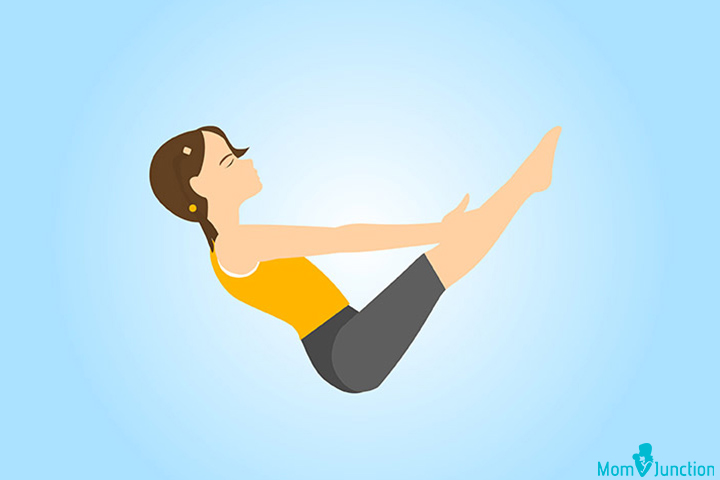
This balanced yoga pose could help children de-stress and revitalize.
How to do it:
Lie flat with feet lined up together and arms at your sides.
Keep your arms and fingers extended toward your toes.
Inhale and as you exhale, lift your chest and feet off the floor, forming a “V” shape.
This will create tension and stretch in the trunk.
The weight of the body will rest on the hips only.
Eyes, hands, and toes should be aligned straight.
Hold the breath and keep the posture for a few seconds.
Exhale slowly while bringing the body back to the neutral position. And relax.
Possible benefits: Strengthens the trunk, arm muscles, shoulders and thighs; excellent for the liver and kidneys; helps reduce constipation and relieves digestive problems.
Warning: If your child has a chronic illness or spinal cord problems, avoid this pose.
13- Happy Baby Pose (Ananda Balasana):
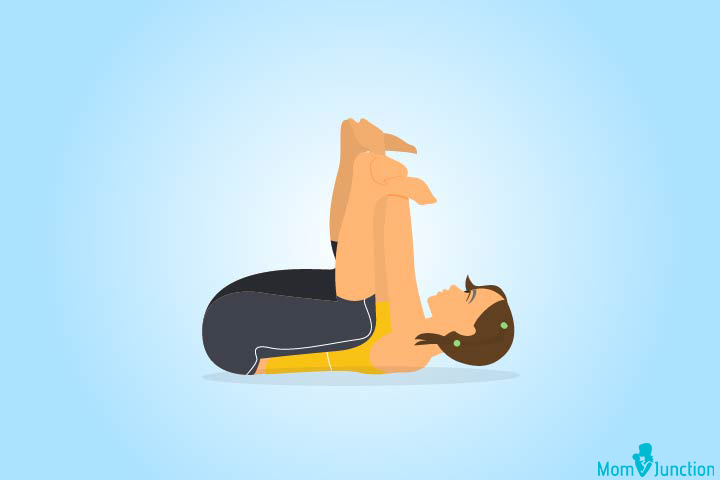
This asana could help relax the joints in the back.
How to do it:
Lie on your back with your knees drawn in toward your chest.
Hold the feet with your hands. Make sure the arms are in front of the torso.
Pull shoulders back.
Gently stretch arms and feet.
Spread the knees as far apart as possible.
Extend the lower back to the floor while touching the tip of the tailbone.
Hold for one minute or less, then release.
Possible benefits: Stretches and opens hips, thighs and inner groin; lengthens spine; strengthens arms and shoulders
Warning: If your child has a knee or ankle injury, consult a physician before performing this pose.
14- Mountain yoga Pose (Tadasana):
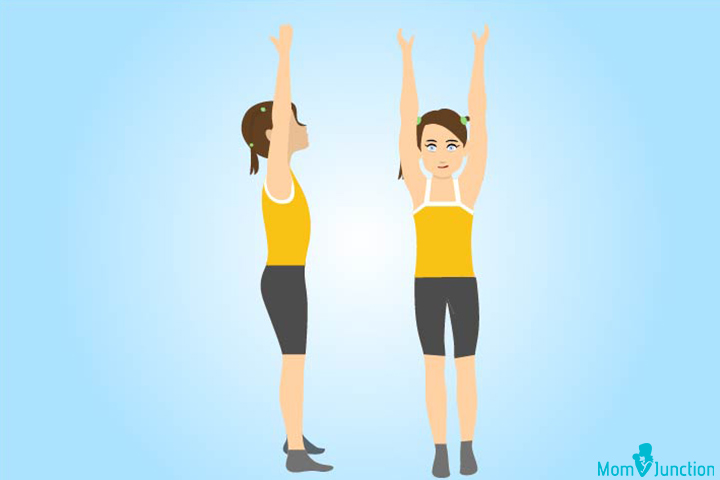
This is a foundational pose for all standing asanas and could be a calm yoga pose for children.
How to do it:
Stand tall and straight.
Spread your legs a few inches apart and spread your toes.
Keep your arms at your sides.
Shoulders should be relaxed and not stiff.
Raise your arms above your head.
Hold the posture and breathe slowly.
Stay as long as you are comfortable.
Possible benefits: Improves posture, strengthens thighs, legs and ankles; firms abdomen and hips; improves sleep
Warning: No warnings to follow.
15- Lion yogaPose (Simhasana):
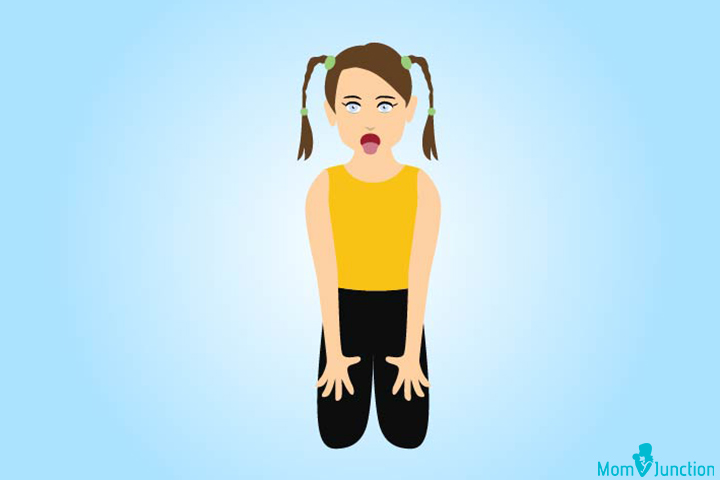
Could help your child de-stress with this animal asana; make it roar and enjoy.
How to do it:
Sit with hips on heels.
Rest palms on knees.
Start breathing in through the nose, and while on top, stick out your tongue.
Keep your eyes wide open, exhale through your mouth, and make a roaring lion sound (Haaa).
Many yoga schools suggest focusing either on the tip of the nose or in the middle of the eyebrows.
Possible Benefits: A great yoga stretch for the lungs, throat and airways; regulates tonsil and immune system function; reduces stress, anger and anxiety; suitable for a hyperactive child.
Warning: Do not repeat more than five times.
A daily routine of yoga activity will make your child more disciplined and focused on their activity and give them the strength to cope with stress. Start with one or two yoga poses to practice at first, and then you can have him try more as he gets used to the practice.
20 yoga poses:
Beginners Online Yoga Class – Classes of 20 Yoga poses: Yoga Online presents a full yoga class for beginners. As yoga classes go, this one is great for fitness and spirituality. This yoga routine contains detailed instructions on 20 basic yoga positions and postures. The postures flow one after the next with a fantastic original sound track ending in a deep relaxation session. This is great for your health and well-being. Suits males and females and covers the fundamental poses of yoga.
Which pose is best for beginners in yoga?
Sukhasana (Easy Pose)
Tadasana (Mountain Pose)
Uttanasana (Standing Forward Bend)
Utkatasana (Chair Pose)
Adho Mukha Svanasana (Downward-Facing Dog Pose)
Sphinx Pose
High Lunge, Crescent Variation
Ananda Balasana (Happy Baby Pose)

